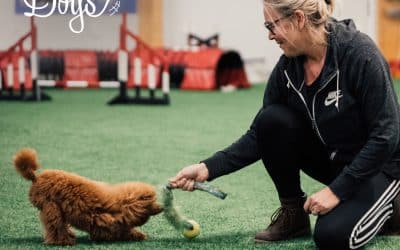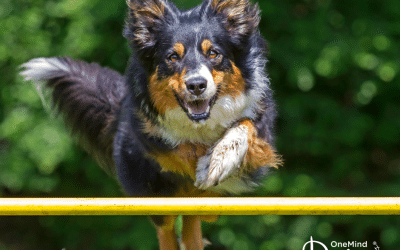Dog agility training is an exhilarating activity that is so much more than just a sport. It strengthens the bond between you and your dog while enhancing your dog’s overall happiness. To truly excel in agility training, it’s essential to cover some important foundation skills and to see things from your dog’s perspective. You must build a solid foundation before diving into obstacle training, advanced moves and coursework.
Inspired by OneMind Dogs Instructor Lynn and her insightful webinar, this guide will walk you through the four essential agility foundation skills and share valuable tips for a successful agility journey.
Four Key Foundation Skills
1. Building a connection and appreciating training together
2. Improving focus and boosting confidence.
3. Fostering forward focus and commitment to obstacles
4. Balance between obstacle and handler focus
1. Building a connection and appreciating training together
A strong and trusting relationship with your dog is the cornerstone of successful agility training. This involves understanding your dog’s preferences, catering to their individual needs, and utilizing rewards that motivate them. Lynn emphasizes the importance of turning dog training into a fun, stress-free experience. In fact, training sessions should be met with the same enthusiasm as a trip to the park, not a bootcamp.
If you have children, It’s also a great idea to involve them in the training process. It helps them better understand behavior and body language, thus fostering a deeper bond between them and the dog.
Rewards
Selecting the appropriate rewards is crucial for creating an enjoyable training environment. Closely observe your dog’s preferences and tweak your training rewards accordingly. Their favorite rewards will keep your dog engaged throughout the training process.
Note that dogs may have different preferences – some might prefer food treats, while others may enjoy playing with a toy or engaging in a game of tug. Try offering various options during training sessions and observe which ones they seem most excited about. Remember, listening to your dog and focusing on its needs is essential to build trust.
If your dog only enjoys food, consider introducing food reward toys, where you can open the toy and place food inside, such as these. This way you can change up how you present the reward and you can place or throw the reward strategically to help your dog learn the task at hand more quickly. It’s also important to be able to place the reward so that your dog doesn’t develop too much handler focus.
Don’t forget, you can use praise and affection as rewards too, especially for dogs that are highly people-oriented. Whatever your dog gets most excited about in life, is the perfect reward!

2. Improving focus and boosting confidence
Another critical foundation skill is teaching your dog to focus on you and the task at hand, rather than distractions in the environment. This becomes much easier when you focus on building confidence in performing agility foundation exercises. You can achieve this by practicing simple, well-defined behaviors in public environments and gradually introducing distractions. Lynn recommends involving your dog in recall games to enhance their recall ability over time and create a fun training environment.
Fun is a keyword here. And it’s paramount in building your dog’s confidence. If they’re having fun, they’ll be more likely to try new things and continue training with the same enthusiasm. This applies not only during the agility course but also to other tasks such as recalls, sits, downs, and stays.
Improving Focus
Without focus, it’s almost impossible for your dog to complete an agility course, or to understand the goal of the exercise you are doing together. Therefore, you must teach them to focus on you even when other dogs and people are around. Start by maintaining your dog’s focus on you amidst low-level distractions. To achieve this, practice simple focus exercises such as eye contact and attention games in a controlled environment.
When you’re out in a public area, ask your dog to focus on obstacles and target points as a reward for performing basic commands such as sits, downs, and recalls.
Adding Distractions and boosting confidence
Gradually introduce distractions to build a strong foundation in agility training. Ensure your dog knows the expected behaviors well and feels confident in unfamiliar environments. The best way to do this is exposing your dog to various distractions. Doing so helps build confidence, resulting in calm and confident performance during agility competitions.
As your dog becomes more proficient at maintaining focus, increase the intensity of distractions. You can add varied stimuli such as noises, other dogs moving and barking, and different environments. For example, practice focus exercises at a local park or near a playground where your dog will be exposed to new sights, sounds, and smells.
If your dog is nervous or anxious in distracting environments, try following these steps:
3. Fostering Forward Focus and Commitment to Obstacles
Next up is developing your dog’s forward focus and commitment to obstacles. This skill enables your dog to perform independently and efficiently during agility trials. As such, it’s time to introduce your dog to the concept of forward-focus techniques in training. This approach also helps your dog build confidence in their abilities. It ensures their attention is on performing the obstacles, rather than just chasing you.
“We aim to get 60% obstacle focus and 40% handler focus”, says OneMind Dogs founding Coach Janita Leinonen. “In the beginning you should aim to get the obstacle focus quite high, even 90%, by letting your dog offer certain behaviors and rewarding mostly on the line, behind the obstacle, than from your hand. Your dogs will learn to read the course better and advance faster from obstacle to obstacle because they want to find the next obstacle themselves.”
“We emphasize obstacle focus because we think the dogs´ main work in agility is to perform obstacles and advance on the course independently towards the next obstacle”, says founding Coach Jaakko Suoknuuti. “This way the dog can help the handler and the team is able to advance more quickly.”
When you have reached a high level of obstacle focus, you can start to take it lower. Janita says: ”This way you can have your dog follow your handling and react more readily to cues for coming close to you. At this point you can start to reward more from your hand or from the collection.
Enhance your dog’s commitment to obstacles by incorporating games and exercises that encourage them to follow your cues and stay focused on the obstacle such as those from our Foundation for Agility program.
Building Commitment
To build commitment, introduce exercises such as the Jump Offering skill, which encourages your dog to fully complete an obstacle. Test your dog’s commitment level and adjust training accordingly to ensure steady progress. In addition, you can add motion to training, as dogs need to learn how to focus on the job at hand even when you are running full speed. Our webinar has a great example of exercises to build commitment.
4. Following the Handling
The last crucial foundation skill is teaching your dog to follow your handling cues while balancing obstacle and handler focus.
Increasing Handler Focus
To increase handler focus, train your dog to follow your cues in the presence of obstacles through Either-Or exercises as shown in our foundation program. In these exercises, you’ll do an exercise one way once, and then another way the next time. Checking that the dog is following you cues and not just guessing. Use toys or food as rewards to encourage the dog to focus on you if you’re having trouble keeping their focus.
One effective way to increase handler focus is by introducing the Following the Handling Exercise from our Foundation for Agility program, as shown in the webinar. To set up this exercise, position yourself a few feet away from your dog, making sure they see you toss a reward (such as a treat or toy) away from you. Your dog, the reward, and you should form a triangle. The aim of this exercise is to have your dog come to you first and then go to the reward.
Begin by pinching your fingers as if you were holding a treat, and then guide your dog towards you. Once your dog reaches you, use a release command or cue (e.g., “Get it!”) to allow them to go towards the actual treat or toy. This exercise encourages your dog to prioritize your guidance and cues before engaging with the reward, thus increasing handler focus. If the dog ignores you and goes straight to the reward, have a helper there to pick it up (or use a closed container), and put food in your hand as well, to reward the dog for coming to you.
Bottom Line
Building a strong foundation is the key to a fun and successful dog agility journey. Focus on developing a solid relationship with your dog, building their confidence, and teaching them to stay committed and follow handling cues. Investing time in these essential foundation skills will set you and your dog up for rewarding dog agility training.
Sign up for our online Foundation for Agility program to get access to more tips, tricks and guidance for teaching your dog agility. Our free webinar is also a great place to start, fill out the form below and it will be in your inbox in 5-minutes!



